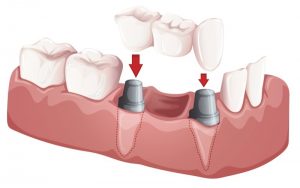A dental bridge is a form of restoration that is used to fix a missing tooth. When there is a gap between two teeth, it can be replaced by the use of a dental bridge. This a cost effective way of restoring a missing tooth in order to restore a smile and enable one to have a restored initial smile. Losing a tooth can cause a social misfit and may cause a person to be embarrassed. It comes in the form of a tooth
and may also be known as a false tooth.
The benefits of dental bridges
- Improve smile- Someone may decide to have dental bridges for the sole purpose of restoring their smile. They may have lost their teeth due to accident, disease or injury. This may be an embarrassment to some individuals thus resorting to dental bridges.
- Cosmetic purposes- Some people use them for the sole purpose of improving their beauty and appearance. They believe that if the gaps are filled, their looks are greatly enhanced.
- Correct the bite and chew related issues – As a result of loss of teeth, there may be difficulty in biting food. In order to correct the condition, one can resort to the use of dental bridges.
- Improve speech- When one loses some teeth, their speech can be easily affected. The pronunciation of some words may be interfered with. This can be sorted out by the use of dental bridges to the missing teeth.
- Reduce risk of gum infections- The dental bridges can also lead to infections which may finally lead to gum disease. They can therefore be considered a protection to the gums in some cases. Food
 may cause injury to the gums which may finally cause infections to the gums.
may cause injury to the gums which may finally cause infections to the gums.
Steps to proper dental bridges procedure
Before one finalizes the decision to have dental bridges, they need to be aware of the following procedure.
- Visit the dentist for a thorough diagnosis. The dentist performs the necessary tests and advises the patient of the option of dental bridges. He also ensures that the bone structure is proper.
- Next, the dental impressions are taken in order to ensure that the bridge that will be fixed will be of the correct fitting. At this stage if the individual has a preferred taste of shape he can tell the dentist to reshape the teeth.
- The dentist then is left to fabricate the teeth according to his client’s needs and specification. He ensures that the false teeth will not affect the neighboring teeth during the procedure.
- The person then comes in and the procedure is done on them. This is after some days or even a week, depending on the schedule of the dentist and the client.